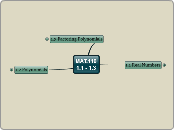MAT.116
1.1 - 1.3
1.1 Real Numbers
The Set of Real Numbers / Representing Real Numbers as Decimals
Rational Numbers
Integers
Whole Numbers
Natural Numbers
Irrational Numbers
Representing Real Numbers on a Number Line
Number Line
Operations with Real Numbers
Rules of Operation
Addition Rules
Multiplication Rules
Distributive Law
Properties of Negatives
Properties Involving Zero
Properties of Quotients (including Fractions)
1.3 Factoring Polynomials
Factoring
Common Factors
Some Important Formulas
Trial-and-Error Factorization
Leading Coefficient 1
Leading Coefficient Not 1
Factoring by Regrouping
Other Methods
1.2 Polynomials
Exponents
Property
Polynomials
Related Vocabulary
Adding and Subtracting Polynomials
Multiplying Polynomials
Special Products
Order of Operations
